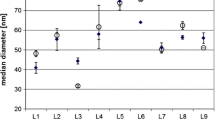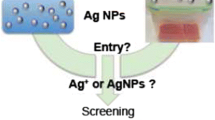Abstract
The feasibility of producing colloidal silver nanoparticle reference materials and silver nanoparticle spiked reference matrix materials was investigated. Two concentrations of PVP-coated silver nanoparticle dispersions were evaluated and used to spike chicken meat, with the aim of producing a set of reference materials to support the development of analytical methods for the detection and quantification of nanoparticles in food. Aqueous silver nanoparticle (AgNP) dispersions were evaluated for their homogeneity of mass fraction and particle size and found sufficiently homogeneous to be used as reference materials. Stability studies at 4 °C, 18 °C and 60 °C demonstrated sufficient short- and long-term stability, although particle size decreases in a linear fashion at 60 °C. The AgNP dispersions were characterized for total Ag mass fraction by ICP-OES, dissolved Ag content by ultrafiltration-ICP-MS, as well as AgNP particle size by dynamic light scattering, transmission electron microscopy (TEM) and gas-phase electrophoretic molecular mobility analysis. Chicken breasts were homogenized by cryo-milling and spiked with aqueous AgNP dispersions. Rapid freezing over liquid nitrogen resulted in homogeneous and stable materials. The spiked chicken materials were characterized for their total Ag mass fraction by neutron activation analysis and for the AgNP particle size by TEM and single-particle inductively coupled plasma mass spectrometry. The observed differences in particle sizes between the spiked chicken samples and the original silver dispersions indicate relevant matrix effects. The materials demonstrate that production and characterization of reference materials for the detection and quantification of silver nanoparticles in meat are feasible, but challenges especially in assessing stability and having sufficiently precise methods for assessment of homogeneity and stability remain.






Similar content being viewed by others
References
EC Regulation 1169/2011 on the provision of food information to consumers
Chaudhry Q, Scotter M, Blackburn J, Ross B, Boxall A, Castle L et al (2008) Applications and implications of nanotechnologies for the food sector. Food Addit Contam Part A 25:241–258
von Goetz N, Fabricius L, Glaus R, Weitbrecht V, Günther D, Hungerbühler K (2013) Migration of silver from commercial plastic food containers and implications for consumer exposure assessment. Food Addit Contam Part A Chem Anal Control Expo Risk Assess 30:612–620
Echegoyen Y, Nerín C (2013) Nanoparticle release from nano-silver antimicrobial food containers. Food Chem Toxicol. 62:16–22
ISO Guide 34, General requirements for the competence of reference materials producers, International Organization for Standardization, Geneva, Switzerland, 2009
Peters RJB, Rivera ZH, van Bemmel H, Marvin HJP, Weigel S, Bouwmeester H (2014) Development and validation of single particle ICP-MS for sizing and quantitative determination of nano-silver in chicken meat. Anal Bioanal Chem. 406:3875–3885 doi:10.1007/s00216-013-7571-0
Feichtmeier NS, Leopold K (2014) Detection of silver nanoparticles in parsley by solid sampling high-resolution-continuum source atomic absorption spectrometry. Anal Bioanal Chem 406:3887-3894. doi: 10.1007/s00216-013-7510-0
Loeschner K, Navratilova J, Købler C, Mølhave K, Wagner S, von der Kammer F, Larsen EH (2013) Detection and characterization of silver nanoparticles in chicken meat by asymmetric flow field flow fractionation with detection by conventional or single particle ICP-MS. Anal Bioanal Chem 405:8185–8195
Gagné F, Turcotte P, Gagnon C (2012) Screening test of silver nanoparticles in biological samples by graphite furnace-atomic absorption spectrometry. Anal Bioanal Chem 404:2067–2072
Menzel M, Bienert R, Bremser W, Girod M, Rolf S, Thünemann AF, Emmerling F (2013) Certification Report Certified Reference Material BAM-N001 Particle Size Parameters of Nano Silver, BAM Federal Institute for Materials Research and Testing, http://www.rm-certificates.bam.de/de/rm-certificates_media/rm_cert_particle_size/bam_n001repe.pdf
MacCuspie RI, Allen AJ, Martin MN, Hackley VA (2013) Just add water: reproducible singly dispersed silver nanoparticle suspensions on-demand. J Nanopart Res 15:1760
Harmon AR, Kennedy AJ, Poda AR, Bednar AJ, Chappel MA, Steevens JA (2014) Determination of nanosilver dissolution kinetics and toxicity in an environmentally relevant aqueous medium. Environ Toxicol Chem 33:1783–1791
Peretyazhko TS, Zhang Q, Colvin VL (2014) Size-Controlled Dissolution of Silver Nanoparticles at Neutral and Acidic pH Conditions: kinetics and Size Changes. Environ Sci Technol 48:11954–11961
Grombe R, Allmaier G, Charoud-Got J, Dudkiewicz A, Emteborg H, Hofmann T, Lehner A, Llinas M, Seghers J, Solans C, von der Kammer F, Wagner S, Linsinger TPJ (2014) Production of reference materials for the detection and size determination of silica nanoparticles in tomato soup. Anal Bioanal Chem 406: 3895–3907. doi: 10.1007/s00216-013-7554-1
Dudkiewicz A, Boxall ABA, Chaudhry Q, Mølhave K, Tiede K, Hofmann P, Linsinger TPJ (2014) Uncertainties of size measurements in electron microscopy characterization of nanomaterials in foods. Food Chem. doi:10.1016/j.foodchem.2014.12.071 (in press)
van der Veen AMH, Linsinger TPJ, Pauwels J (2001) Uncertainty calculations in the certification of reference materials. 2. Homogeneity study. Accred Qual Assur 6:26–30
Linsinger TPJ, Pauwels J, van der Veen AMH, Schimmel H, Lamberty A (2001) Homogeneity and stability of reference materials. Accred Qual Assur 6:20–25
Lamberty A, Schimmel H, Pauwels J (1998) The study of the stability of reference materials by isochronous measurements. Fres J Anal Chem 360:359–361
Loeschner K, Navratilova J, Legros S, Wagner S, Grombe R, Snell S, von der Kammer F, Larsen EH (2013) Optimisation and evaluation of asymmetric flow field-flow fractionation of silver nanoparticles. J Chrom A 1272:116–125
Cunningham WC, Stroube WB (1987) Application of an instrumental neutron activation analysis procedure to analysis of food. Sci Total Environ 63:29–43
Linsinger TPJ, Peters R, Weigel S (2014) International interlaboratory study for sizing and quantification of Ag nanoparticles in food simulants by single-particle ICPMS. Anal Bioanal Chem 406:3835–3843
ISO Guide 35, Reference materials—General and statistical principles for certification, International Organization for Standardization, Geneva, Switzerland, 2006
Acknowledgments
The work leading to these results has received funding from the European Union Seventh Framework Programme (FP7/2007–2013) under grant agreement no 245162. The authors thank Mrs. Meeus (EC JRC-IRMM) for conducting the microbiology tests.
Author information
Authors and Affiliations
Corresponding author
Electronic supplementary material
Below is the link to the electronic supplementary material.
Rights and permissions
About this article
Cite this article
Grombe, R., Allmaier, G., Charoud-Got, J. et al. Feasibility of the development of reference materials for the detection of Ag nanoparticles in food: neat dispersions and spiked chicken meat. Accred Qual Assur 20, 3–16 (2015). https://doi.org/10.1007/s00769-014-1100-5
Received:
Accepted:
Published:
Issue Date:
DOI: https://doi.org/10.1007/s00769-014-1100-5




